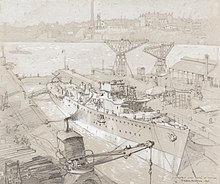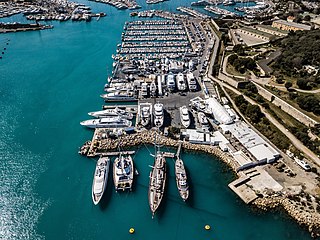
A shipyard, also called a dockyard or boatyard, is a place where ships are built and repaired. These can be yachts, military vessels, cruise liners or other cargo or passenger ships. Compared to shipyards, which are sometimes more involved with original construction, dockyards are sometimes more linked with maintenance and basing activities. The terms are routinely used interchangeably, in part because the evolution of dockyards and shipyards has often caused them to change or merge roles.

HMAS Success was a Durance-class multi-product replenishment oiler that previously served in the Royal Australian Navy (RAN). Built by Cockatoo Docks & Engineering Company in Sydney, Australia, during the 1980s, she is the only ship of the class to be constructed outside France, and the only one to not originally serve in the Marine Nationale. The ship was part of the Australian contribution to the 1991 Gulf War, and was deployed to East Timor in response to incidents in 1999 and 2006. The ship was fitted with a double hull during the first half of 2011, to meet International Maritime Organization standards.

The Bathurst-class corvettes were a class of general purpose vessels designed and built in Australia during World War II. Originally classified as minesweepers, but widely referred to as corvettes, the Bathurst-class vessels fulfilled a broad anti-submarine, anti-mine, and convoy escort role.

Cockatoo Island Wareamah is a UNESCO World Heritage Site at the confluence of the Parramatta River and Lane Cove River in Sydney Harbour, New South Wales, Australia.
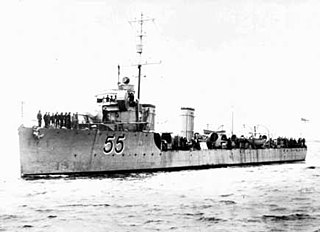
HMAS Parramatta, named after the Parramatta River, was a River-class torpedo-boat destroyer of the Royal Australian Navy (RAN). Ordered in 1909 for the Commonwealth Naval Forces, Parramatta was the first ship launched for the RAN. Temporarily commissioned into the Royal Navy for the delivery voyage to Australia, the destroyer came under Australian naval control in 1910, and was recommissioned into the RAN on 1 March 1911, shortly before the latter's formal creation.
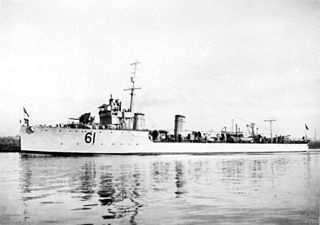
HMAS Swan was a River-class torpedo-boat destroyer of the Royal Australian Navy (RAN). One of six built for the RAN, Swan was built at Cockatoo Island Dockyard, and entered service in 1916. The early part of the ship's career was spent on blockade duty in the Far East, before she was transferred to the Mediterranean for anti-submarine duty. Apart from performing shore bombardment during the Second Battle of Durazzo, Swan's wartime career was uneventful. The destroyer was placed in reserve in 1920, but was reactivated between 1925 and 1927 and assigned to Tasmania. Swan was decommissioned in 1928, stripped of parts, and sold for use as prisoner accommodation on the Hawkesbury River. After changing hands several times, the hull sank during gale conditions in 1934.

HMAS Yarra, named for the Yarra River, was a River-class torpedo-boat destroyer of the Royal Australian Navy (RAN). Ordered in 1909 for the Commonwealth Naval Forces, Yarra was temporarily commissioned into the Royal Navy on completion in 1910 and handed over to Australian control on arrival in Australia.

HMAS Torrens, named for the River Torrens, was a River-class torpedo-boat destroyer of the Royal Australian Navy (RAN). The destroyer was built at Cockatoo Island Dockyard and entered service with the RAN in 1916. The destroyer was first deployed to East Asia, then the Mediterranean, where she remained for the rest of World War I. After returning to Australia, the destroyer was decommissioned, but saw use in several ports for reservist training before the decision to sell her for scrap was made. After being stripped, the destroyer was towed outside Sydney Heads, used for gunnery practice, and scuttled.

The River class was a class of six torpedo-boat destroyers operated by the Royal Australian Navy (RAN). The design was based on a modified version of the British River-class destroyer, 13 of which were planned under the 1904 Naval Estimates, but were cancelled before orders were placed. The first batch of three ships was ordered for the Commonwealth Naval Forces in 1909, followed later by a second batch of three a few years later. All six vessels are named after Australian rivers.

HMAS Warrego, named for the Warrego River, was a River-class torpedo-boat destroyer of the Royal Australian Navy (RAN). Ordered in 1909, construction of the destroyer started in Scotland, but she was then broken down and reassembled at Cockatoo Island Dockyard in order for the Australian shipbuilding industry to gain experience in warship construction. Warrego was commissioned into the RAN in 1912, and spent her early career operating in Australian waters.

HMAS Warrego (L73/U73), named for the Warrego River, was a Grimsby-class sloop of the Royal Australian Navy (RAN).

The Garden Island Naval Chapel is a heritage-listed non-denominational Christian chapel located in the heritage-listed Garden Island Naval Precinct that comprises a naval base and dockyard in the inner eastern Sydney suburb of Garden Island in the City of Sydney local government area of New South Wales, Australia.

Mort's Dock is a former dry dock, slipway, and shipyard in Balmain, New South Wales, Australia. It was the first dry dock in Australia, opening for business in 1855 and closing more than a century later in 1959. The site is now parkland.
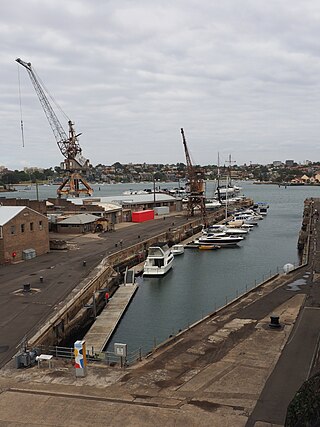
Sutherland Dock is a heritage-listed dockyard at the former Cockatoo Island Dockyard, Cockatoo Island, New South Wales, Australia. It was added to the Australian Commonwealth Heritage List on 22 June 2004.
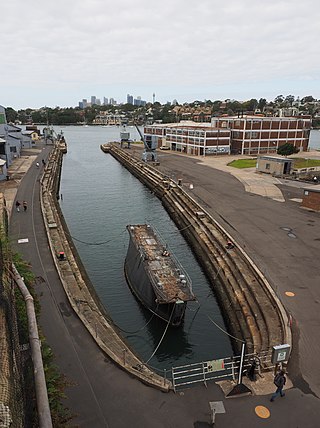
Fitzroy Dock is a heritage-listed dockyard at the former Cockatoo Island Dockyard, Cockatoo Island, Sydney Harbour, New South Wales, Australia. It was added to the Australian Commonwealth Heritage List on 22 June 2004.
The Cockatoo Docks & Engineering Company was a ship building and maintenance company which operated the Cockatoo Island Dockyard on Cockatoo Island in Sydney, Australia, between 1933 and 1992.

HMAS Parramatta Shipwreck and Memorials is a heritage-listed shipwreck at Cascade Gully, Hawkesbury River, Bar Point, Central Coast, New South Wales, Australia. The heritage listing also includes three related memorials, two at Queens Wharf Reserve in Parramatta and one at Garden Island in Sydney. The original HMAS Parramatta was commissioned in 1910, paid off in 1928, and wrecked in 1934. The bow and stern sections were subsequently converted into memorials, while the third memorial relates to the second HMAS Parramatta, sunk in service at Tobruk in World War II. It was added to the New South Wales State Heritage Register on 15 December 2006.

Cockatoo Island Industrial Conservation Area is a heritage-listed protected area relating to the former Cockatoo Island Dockyard at Cockatoo Island, Sydney Harbour, New South Wales, Australia. It was added to the Australian Commonwealth Heritage List on 22 June 2004.

The Garden Island Naval Precinct is a heritage-listed naval base and defence precinct located at Cowper Wharf Roadway in the inner eastern Sydney neighbourhood of Garden Island, New South Wales, Australia. The precinct was built from 1856. It includes the HMAS Kuttabul naval base, formerly known as HMAS Penguin. The property is owned by Australian Department of Defence. It was added to the Commonwealth Heritage List on 22 June 2004 and the New South Wales State Heritage Register on 12 November 2004.

